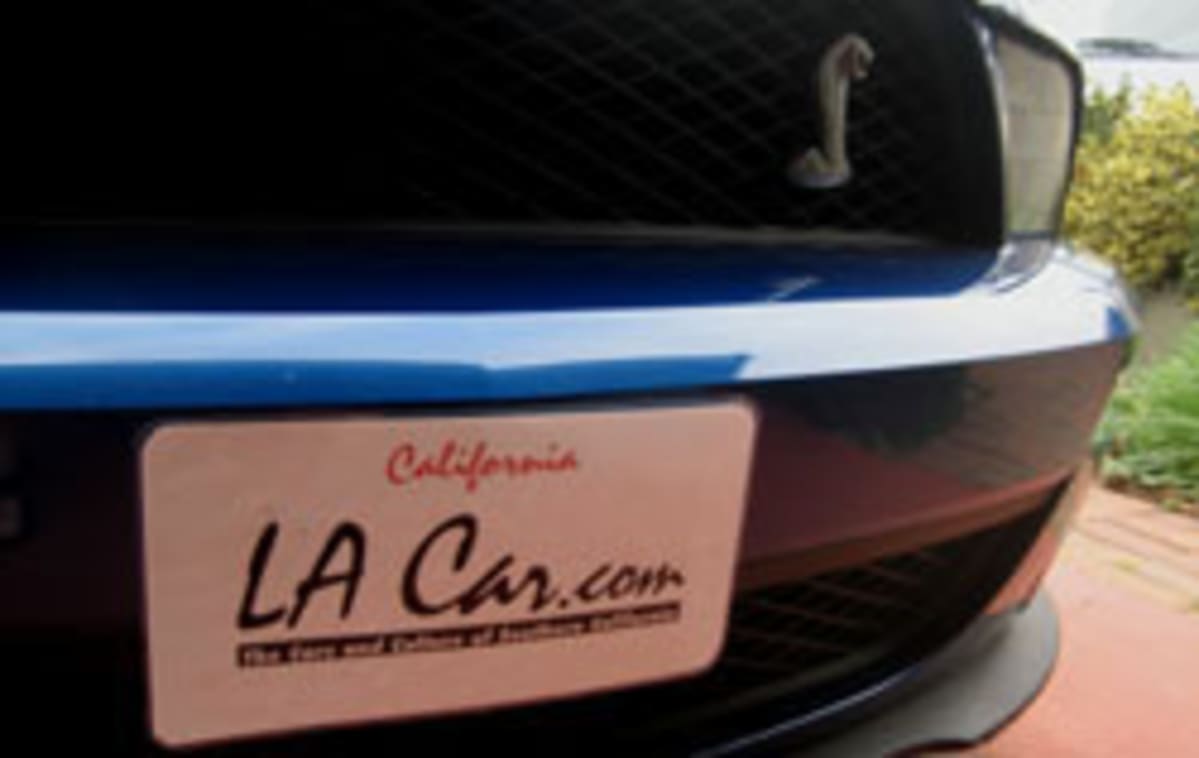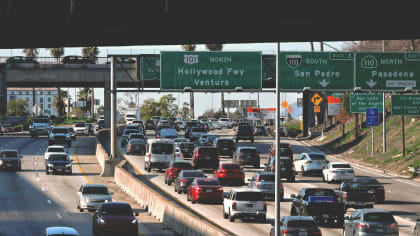BACK SEAT DRIVING - JUNE 2007
This article is from our archives and has not been updated and integrated with our "new" site yet... Even so, it's still awesome - so keep reading!
Published on Thu, May 31, 2007
By: The LACar Editorial Staff
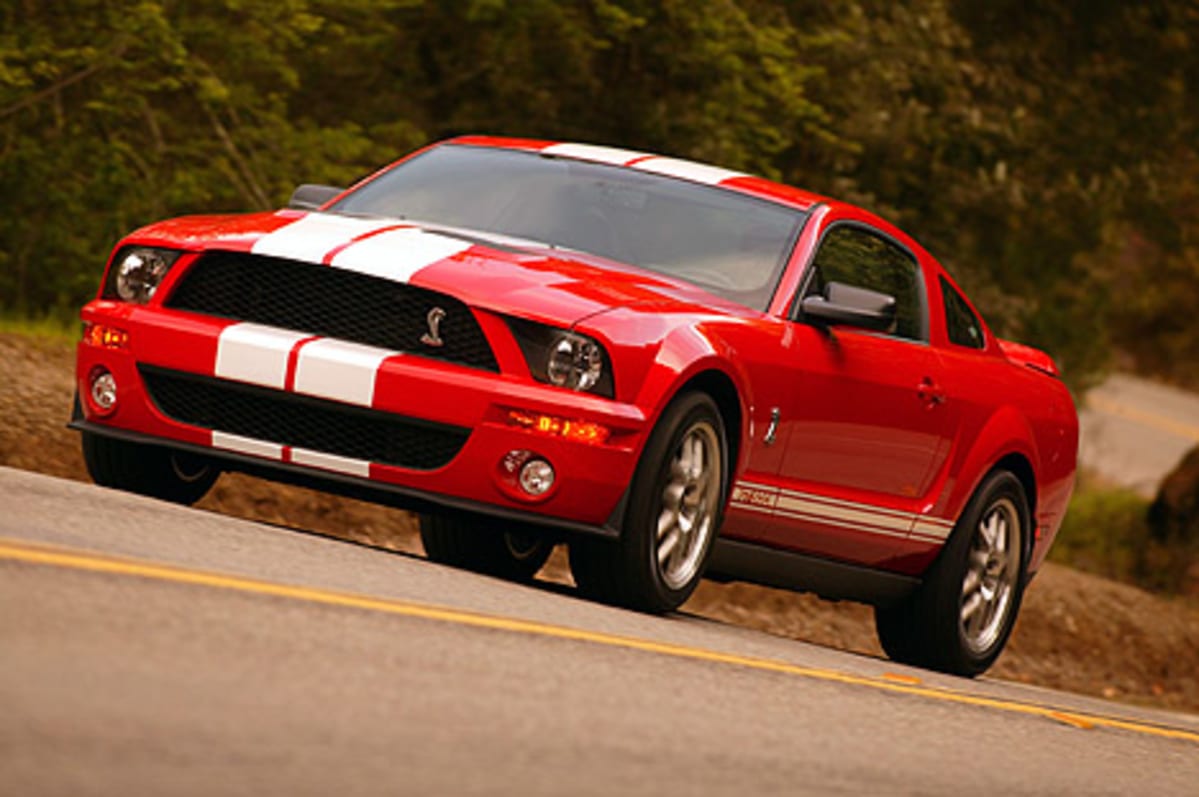
A violation of Commandment No. V
NAKANO: BACK SEAT DRIVING DRIVERS' TEN COMMANDMENTS - ANNOTATED When the Vatican issued its "Drivers' Ten Commandments" it left a few questions as to how the declarations should be interpreted. Like, what exactly does "kill" mean in "you shall not kill"? Not one to be at a loss for answers, LA Car turned to some of its crack lawyers to provide the exact meanings behind the Vatican's declarations (LA Car, by the way, boasts the largest number of staff attorneys of any automotive publication on the planet). So for those who have been wondering, here are the drivers' ten commandments, as issued by the Vatican, and the legal meanings behind them: I. You shall not kill. Road kill. Avoid running over deer, rabbits, cats, dogs, skunks and other four-legged creatures. Two-legged creatures are to be avoided as well. II. The road shall be for you a means of communion between people and not of mortal harm. See No. I. Just because they don't die doesn't make it okay. III. Courtesy, uprightness and prudence will help you deal with unforeseen events. Lay off the horn, lay off the liquor (or any other controlled substances), don't recline your seatbacks too much, and make sure you had plenty of sleep before getting behind the wheel. IV. Be charitable and help your neighbour in need, especially victims of accidents. The one redeeming use of cell phones in the car: Call in for help. V. Cars shall not be for you an expression of power and domination, and an occasion of sin. Avoid muscle cars, sport cars, sport sedans, tuners, hot rods, SUVs, and big trucks. Hybrids will tend to make you smug, so avoid those as well. Recommended transportation: Mercury Grand Marquis, Ford Crown Victoria, most Buicks and other vehicles where the median buying age is over 60 years old. VI. Charitably convince the young and not so young not to drive when they are not in a fitting condition to do so. In other words, don't ever let them drive. VII. Support the families of accident victims. Send donations to MADD (Mothers Against Drunk Drivers), RAADD (Recording Artists Against Drunk Drivers), ATLA (Association of Trial Lawyers in America), or other similar groups. VIII. Bring guilty motorists and their victims together, at the appropriate time, so that they can undergo the liberating experience of forgiveness. It's called a tort claim, and the trial lawyers are especially pleased with this one. IX. On the road, protect the more vulnerable party. Despite the natural tendency to do the opposite, drivers of large SUVs should be especially courteous when driving next to smaller vehicles. Of course, if it's mano-a-mano with another large SUV, all bets are off. X. Feel responsible towards others. That gas-guzzling, global-warming Hummer H1 you've had your eye on? You may need to deep six that fantasy. Of course, you can always do what The Governator did, and have it run on hydrogen fuel cells. But, then again, watch out for smug pollution (see Commandment No. V). Your Back Seat Driving comments can be sent to: Letter to the Editor
NAKANO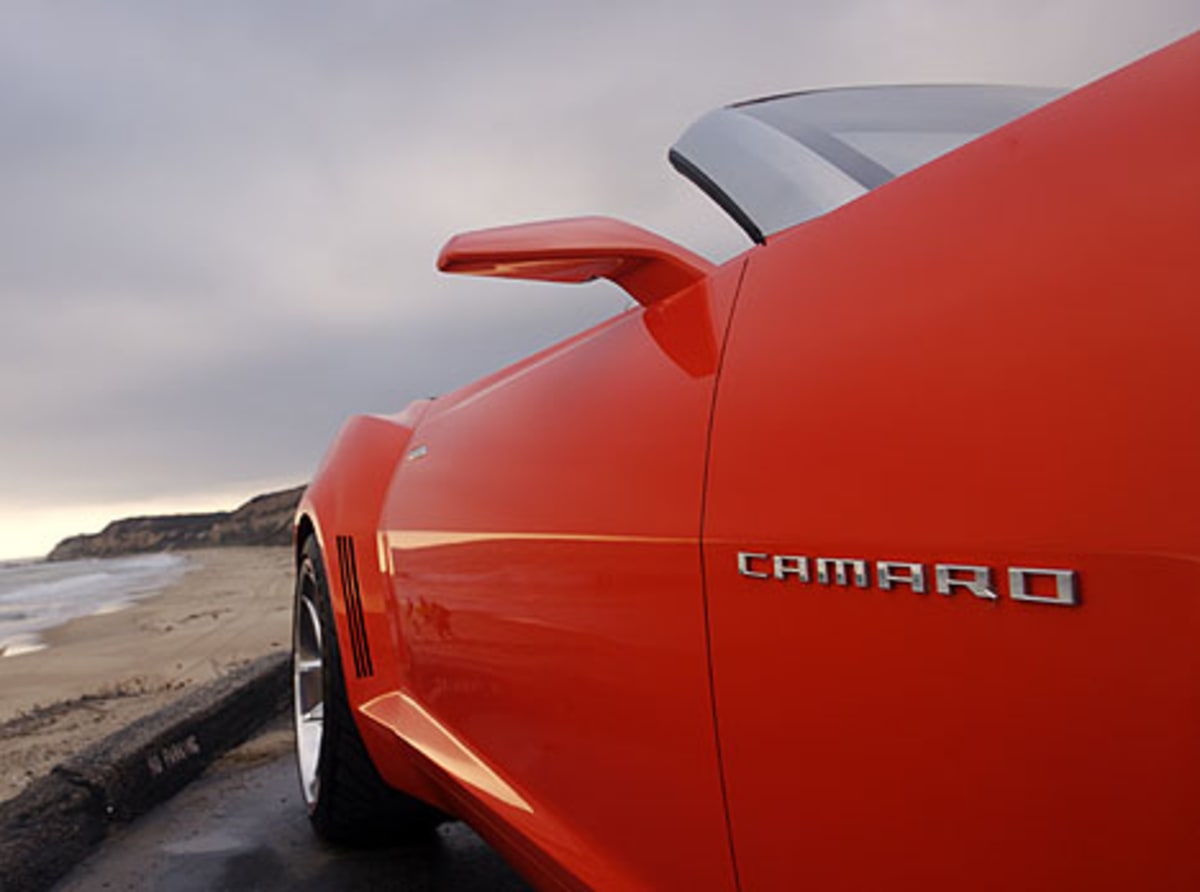
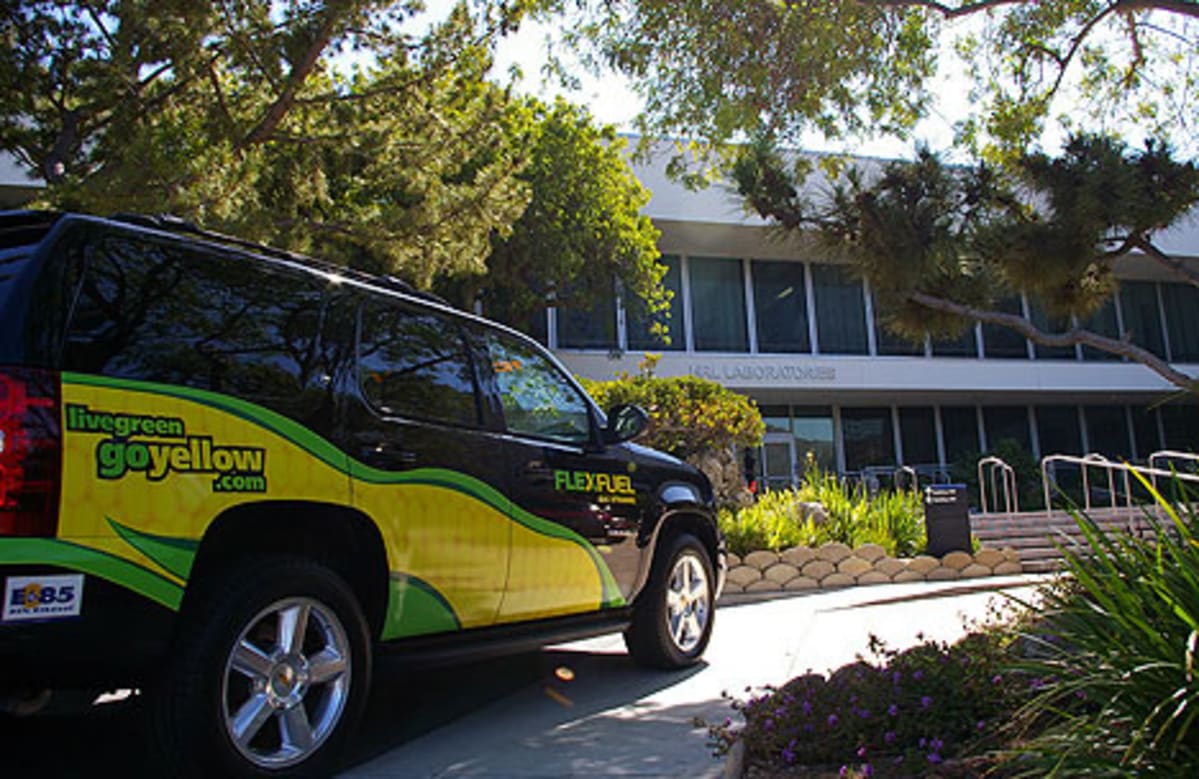
GRAFMAN: BACK SEAT DRIVING ROCKET SCIENCE? OR PERHAPS AN OLD DOG CAN LEARN A NEW TRICK From high atop the Malibu hillside campus of Hughes Research Lab you can see almost forever. Those who work here tell us they can see far, so far that they can peer into the future. Now that is having some vision indeed. Some say that making cars isn't rocket science, yet that's the type of people we are dealing with here. Dr, Ganz, President and CEO of HRL, works along side just a few hundred highly talented individuals in the same facility that was the first to demonstrate a laser, to more recent work on Ion Propulsion and MicroElectroMechanical Switches (MEMS). This building has been the birthplace for more high tech developments since 1959 than you can shake a test tube at. GM is looking at leveraging its investment in HRL to create the rebirth of the automobile as we know it within the next few years. Sounds good to us. Coming out of its funk, GM is poised to show the world it is capable of learning from its mistakes. This time the mega corporation is taking no chances by covering all possible angles when it comes to powering the next generation of cars and trucks. Troy Clarke, President of GM North America, covers the strategy to have the ability to use any technology that suits the public. While this sounds acceptable, the planned emphasis is on electric power as it is renewable, and breaks our foreign dependence on fuel. It did feel that diesel would not be a part of the new direction, at least here in America. Reason being, according to Troy Clarke in a brief Q and A session with just a couple media outlets present, is the additional costs to have a clean diesel adds too much to the cost of the basic car. Hmm, but adding a hybrid system isn't? The focus and maybe the challenge is being able to create a battery that can rise to the occasion. Unfortunately, the lithium ion batteries so valued are manufactured in Japan and off limits to all but the domestic Japanese manufacturers. So General Motors is in hot pursuit to produce a home grown variety. You know, keeping it green, or was that mellow yellow. From the looks of it, GM with the help of emerging technology is going to wean off of the petrol habit sooner than latter to the delight of many. So right now all of the Camaro fanatics are freaking out. Get a grip, this is going to be a progressive change, baby. But just to be on the safe side, buckle up and keep a barrel of high octane stashed away just in case! - John Grafman To view Troy Clarke's presentation, see Troy Clarke at HRL Labs More info at www.gm.com and www.hrl.com Your Back Seat Driving comments can be sent to: Letter to the Editor
NAKANO: BACK SEAT DRIVING DOES HIGHER GAS MILEAGE MEAN LESS SAFE CARS? In the radio commercial currently blitzing the airwaves, the voice of an SUV-loving soccer mom says, "Congress is about to pass a law that's going to make it harder and harder to find" and purchase bigger vehicles. She adds: "Automakers are going to be forced to build smaller and smaller cars." "I'm all for better fuel economy," says her sympathetic friend, "But for me, safety is my top concern." A variation of the commercial is also hitting the Internet: "Rather than letting the experts at the National Highway Traffic Safety Administration decide what standard is technologically feasible, the legislation mandates a standard that could compromise safety." The commercials come courtesy of the Alliance of Automobile Manufacturers, a Washington-based trade association that represents General Motors, Ford, Daimler-Chrysler, Toyota, and other automakers. "Study after study has confirmed that when meeting sharply increased fuel-economy standards, manufacturers are forced to make smaller, lighter, and less powerful vehicles - so safety trade-offs can be a consideration," says Wade Newton, a spokesman for the Alliance, speaking to Mark Clayton of the Christian Science Monitor. As Congress renews the debate over whether to boost Corporate Average Fuel Economy (CAFE) standards for new cars and light trucks, some experts are not sure the argument holds water, reports Clayton. Hard Science or Urban Legend? According to the CSM report, recent research suggests that new technology can make small cars safer and guzzlers more efficient. The study just released by the International Council on Clean Transportations finds that some fuel-efficient cars are already safer than bigger, less less-efficient counterparts. "There's no reason that higher fuel-economy standards would force automakers to change th structural integrity or crash-worthiness," says David Greene to CSM. Greene is an Oak Ridge National Laboratory researcher and co-author of the recently released study. "It's unfortunate that manufacturers are trying to cast the debate in that way." The report asserts that technology can help make cars and trucks lighter and more efficient without compromising their safety. The study concludes that manufacturers can use advanced materials to increase both fuel economy and safety without reducing a vehicle's functionality. It also finds that reducing the weight and height of the heaviest SUVs and pickup trucks will simultaneously increase both their fuel economy and overall safety. "The public, automakers, and policymakers have long worried about trade-offs between increased fuel economy in motor vehicles and reduced safety. The conclusion of a broad group of experts on safety and fuel economy in the auto sector is that no trade-off is required" the study concludes. "There are a wide variety of technologies and approaches available to advance vehicle fuel economy that have no effect on vehicle safety." "Not all automakers are sending up red flares," says Clayton. "American Honda Motor Co., the US division of Japanese maker Honda, has done at least four recent studies on the size, weight, and safety of vehicles and concludes design and technology are the most critical issues." "It is certainly possible to put out fuel-economy requirements so stringent that automakers would have no choice but to downsize vehicles," said John German to CSM. German is the manager of Environmental and Energy analysis for Honda Motor. "But if you do the fuel-economy requirements in any reasonable kind of manner, there shouldn't be any safety impacts." Your Back Seat Driving comments can be sent to: Letter to the Editor
NAKANO:
BACK SEAT DRIVING
ARE VW ENTHUSIASTS WACKED?
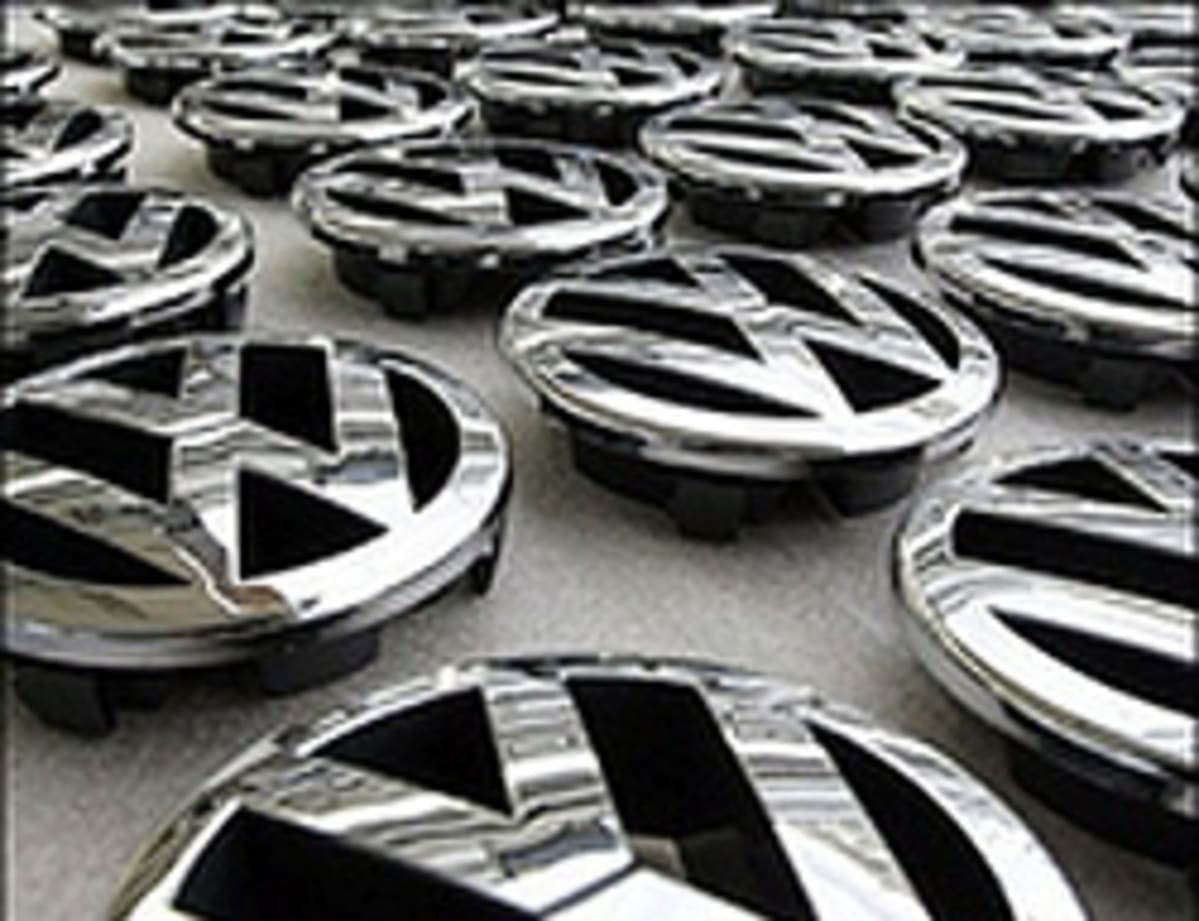
VW Repeats as Best Full-Line Carmaker by Strategic Vision "Volkswagen enthusiasts are the most wacked owners out there," quips our Managing Editor. "How else do you explain how they have the largest message board under the sun, even though overall VW sales are nowhere near the top." He's referring to VWVortex.com, which Big Boards ranks as the most active automotive forum in the world. The Vortex is filled with comments from Volkswagen owners on everything from replacing a grab handle on a Passat with an eyeglass holder from the New Beetle, to what angle drivers prefer to have their center console armrest tilted. The forum is also filled with a number of owners complaining about their dealers and reoccurring problems with their cars. Notwithstanding the complaints, they keep going back and buying Volkswagens. This may explain in part why Volkswagen has been named the best-full line manufacturer by Strategic Vision for the second consecutive year. Says Alexander Edwards, president, Strategic Vision. "Overall, Volkswagen vehicles have proven to be of high-quality and owners are passionate about the brand and their vehicles." "Volkswagen has continued to do well in the Strategic Vision Total Quality Awards" said Adrian Hallmark, executive vice president, Volkswagen of America. "It reiterates that our vehicles are well crafted and fun to drive and that our owners are some of the most passionate drivers in the market." The Strategic Vision Total Quality Index looks at all aspects of the ownership experience, from buying and owning to driving. It correlates satisfaction with the complete ownership experience, perception of quality, owner reported delight, future purchase intent and emotional attachment to the vehicle. Remember the Volkswagen commercial with the owner parking on the far end of the supermarket parking lot? It's standard operating procedure for VW enthusiasts. Your Back Seat Driving comments can be sent to: Letter to the Editor
NAKANO: BACK SEAT DRIVING GOOD RIDDANCE, HONDA ACCORD HYBRID Honda Motor Corporation announced it will pull the plug on the gasoline-electric Accord Hybrid. I say good riddance. If there is ever a car without a compelling reason to exist, it's the Honda Accord Hybrid. It probably sounded like a good idea when it was on the drawing boards: Be the first gas-electric hybrid designed to maximize performance rather than gas mileage. So when the Accord Hybrid made its debut back in 2004, it was outfitted with a six-cylinder internal combustion engine and an electric assist motor. The combination generated 255 horsepower, and did it in a fashion that's clean enough to be rated by the EPA as a Level II Super Ultra Low Emissions (SULEV II) vehicle. The problem? 255 horsepower isn't all that much power. For the same money, you can get a non-hybrid Volkswagen Passat 3.6L that generates 280 horsepower. And guess what? The Passat is also a SULEV II-rated vehicle. A better performance alternative to the Accord Hybrid can even be found in Honda's own backyard, in the form of the 258-horspower Acura TL sedan. Since the Accord Hybrid was not designed to maximize gas mileage, it's fuel efficiency is predictably unremarkable. Under the revised EPA standards, it gets a combined city and highway average of 27 miles per gallon. The four-cylinder Accord does almost as well at 25 miles per gallon (26 if you opt for a manual transmission). In California, the four-cylinder Accord also meets EPA's SULEV II rating - and you'll save about $10,000 off the sticker price. For another $5,000 less, you can get a non-hybrid Honda Civic that significantly beats the Accord Hybrid in the gas mileage category. Evidently, all of this has not gone unnoticed by the buying public. Honda sold a mere 439 Accord hybrids in the United States last month. By contrast, Toyota Motor Corp. sold 24,009 of its less-expensive and gas mileage-leading Prius model during the same month. But an even closer competitor to the Accord Hybrid is Toyota's Camry Hybrid. Unlike, the Accord, Toyota opted to maximize gas mileage for the Camry Hybrid - and with a combined city and highway average of 34 mpg under the EPA's new standard (39 under the old standard), it trounces the Accord Hybrid in fuel efficiency. Moreover, the sticker price on the Toyota version is $26,820 - about $5,000 less than the Accord Hybrid. Even Ford's Escape Hybrid SUV gets a combined average of 32 mpg under EPA's new standard - far better than the Accord Hybrid. So, where does this leave the Honda Accord Hybrid? Out the door, evidently. Honda doesn't make too many mistakes, but the Accord Hybrid represents an unremarkable application and execution of hybrid technology. It excels in neither performance, gas mileage, nor emissions control. Honda made the right move when it decided to pull the plug on the vehicle. Your Back Seat Driving comments can be sent to: Letter to the Editor
NAKANO: BACK SEAT DRIVING HYUNDAI TOPS TOTAL QUALITY INDEX Perceived Quality the New Paradigm, Says Strategic Vision For the first time ever, the Hyundai brand has produced the most leaders on Strategic Vision's Total Quality Indexâ„¢ (TQI), leading in three segments. The San-Diego-based research firm today announced 2007 results, based on the ratings of new vehicle owners in 19 product segments. The only other brand to produce three leaders was Nissan. Hyundai Motors had a total of five leaders (the Kia brand earning two more), Ford Motor and BMW Group each earned three (one for BMW, two for Mini); GM, Honda, and Mercedes each earned two with Dodge, Lexus and Volkswagen each earning one. BMW repeated as the top scoring brand, the eighth time in nine years, and Volkswagen of America kept its claim as the best full-line corporation. The Total Quality Indexâ„¢ is the premier measure of new vehicle owner satisfaction. It asks buyers to rate all aspects of the ownership experience, from buying and owning to driving. Although Toyota improved overall with their TQI scores, the most significant change in 2007 is the lack of any Toyota brand segment leaders. Examining the number of problems or Things-Gone-Wrong per vehicle (the traditional definition of quality), Toyota and Lexus are still among the best. However, Toyota's lead in this narrower definition of quality is now shared with other brands like Honda, Hyundai, Infiniti and domestic brands such as Ford. For example, the Ford Expedition EL enjoyed a very large lead and had fewest problems in the segment. Expedition EL owners recognized innovative changes, which are key to future domestic success. "With automotive corporations now doing a terrific job in providing vehicles with minimal problems, the Cues of Quality (those product attributes that signal quality and create customer Trust) have a greater impact on the purchase decision. Perceived Quality has the power to change customer's perceptions of a vehicle from being 'interesting' to eventually considered and purchased" says Alexander Edwards, Strategic Vision President. "In the past, one could count the number of problems per vehicle; but for automotive customers today and tomorrow, a comprehensive and integrated perception of the ownership experience will be what drives the decision making process." "Even though Hyundai is often overlooked by the US customer, Hyundai's success in 2007 is not surprising given its' current products and press in leadership that is looking to the near and distant future with new designs from styling to powertrain" reports Dr. Darrel Edwards, Founder and CEO of Strategic Vision. Long time leader Honda Odyssey (five years in a row) has now been replaced by the Hyundai Entourage, Kia Sedona and Nissan Quest in a three-way tie for this segment. The Ford F-150 returns to a leadership position in this most tightly contested segment, tied with the Nissan Titan. Buyers rated the following vehicles tops in their segments: Segment Winners (TQI Score) Small Car - Honda Civic (882) Small Multi-Function - Volkswagen Rabbit (880) Medium Car - Saturn Aura (892) & Nissan Maxima (891) Large Car - Hyundai Azera (901) Small Specialty Under $25,000 - Mini Cooper (911) Near Luxury Car - BMW 3-Series Sedan (919) Luxury Car - Mercedes-Benz S-Class Sedan (938) Convertibles Under $30,000 - Mini Cooper Convertible (905) Convertibles Over $30,000 - Chevrolet Corvette Convertible (930) Minivan - Kia Sedona (866), Hyundai Entourage (866) & Nissan Quest (865) Small SUV - Hyundai Santa Fe (885) Medium SUV - Kia Sorento (889) Medium Crossover - Dodge Magnum (882) Large SUV - Ford Expedition EL (918) Near Luxury SUV - Lexus RX 350 (905) Luxury SUV - Mercedes-Benz ML (915) Standard Pick-Up - Honda Ridgeline (879) Full-Size Pickup Nissan Titan (876) & Ford F-150 (875) Heavy Duty Pickup - Ford F-250/350 (876) "Unlike last year, we're seeing many new or redesigned vehicles not ranking near the top of their segments." says Alexander. "These vehicles typically have the potential to deliver more rational and emotional elements which are relevant to buyers. Although the Honda Fit, Nissan Versa and Toyota Yaris all did well, they did not hit the same emotional cord which resounded in the DNA of the Volkswagen Rabbit buyers." Responses from more than 27,000 buyers who bought 2007 models in September, October and November of 2006 were used to calculate the Total Quality Indexâ„¢. Strategic Vision has calculated TQI annually since 1995. Since its incorporation in 1989, Strategic Vision has studied consumer and constituent decision-making for the widest variety of clients, including most auto manufacturers, Coca-Cola, American Airlines, Procter and Gamble, most advertising agencies. Its unique expertise is identifying consumers' motivational hierarchies, including the values that shape perceptions and capture the customers' emotional responses and drive behavior. The firm's in-depth Discovery Interviews and ValueCentered Surveys provide comprehensive, integrated, and actionable outcomes. Your Back Seat Driving comments can be sent to: Letter to the Editor
NAKANO: BACK SEAT DRIVING SAAB AND VOLVO TOP IIHS CRASH TEST FOR CONVERTIBLES In The First IIHS Of Convertibles, Three Are Marginal In Side Impact The Saab 9-3 and Volvo C70 earn the Insurance Institute for Highway Safety's "Top Safety Pick" award for superior crash protection in the first tests the Institute has conducted of 10 midsize convertible models. The Saab and Volvo earn the top rating of good for protection in front, side, and rear crashes, and both models include standard electronic stability control (ESC), which research shows can help drivers avoid crashes. The lowest rated convertible model overall is the Pontiac G6. It's acceptable for frontal crash protection but only marginal for protection in side and rear impacts. While the Audi A4 and BMW 3 series earn good ratings in frontal offset tests, both are rated marginal for side impact protection and poor for protection in rear crashes. The Top Safety Pick designation is an effort by the IIHS to make it easier for consumers to find top-rated vehicles without sorting through reams of crash test results. To earn this award, a vehicle must have "Good" ratings in all three Institute crash tests. It also must have ESC. The Institute adds a requirement for convertibles which must be equipped with rollbars designed to preserve occupants' headroom if a convertible rolls over. Both the 9-3 and C70 are equipped with standard pop-up rollbars behind the rear head restraints that deploy if sensors detect a serious crash. "The performances of the 9-3 and C70 are impressive," says Institute president Adrian Lund. "These cars combine what convertible buyers should look for if they're shopping with safety in mind. The Saab and Volvo not only provide good protection in high-speed front and side crashes but also have good seat and head restraint designs for protecting against whiplash in rear crashes." "We wanted to test convertibles because sales are increasing," Lund says. "We also wanted to evaluate a group of vehicles that automakers wouldn't expect us to test to see if crashworthiness improvements in mainstream cars also are being built into convertibles. For the most part we found that this is happening." Five models earn the highest rating of good for front and side crash protection. Seven of the 10 convertibles have standard side airbags designed to protect the heads of occupants in the front seats, and 8 have ESC as standard or optional equipment. Absence of roof is inherent disadvantage: High-speed crashes are violent events, and the roof of a hardtop helps to keep people's heads and arms from flailing outside the vehicle. Roofs also provide protection if a vehicle rolls over. Data from real-world crashes indicate that the overall risk of death isn't higher in a convertible, but this doesn't mean there aren't any safety disadvantages. The absence of a roof makes it a challenge to design a convertible for safety. The roof helps to maintain the rigidity of the structure around the occupant compartment and keep the compartment intact in a serious crash. The main structures of convertibles have to be strengthened to compensate for the support that's lost in removing the roof. The Institute's crash test results show that many modern convertibles compensate well. For example, the 9-3 convertible achieves the same good front, side, and rear crash test ratings as the four-door sedan version. Big price tag doesn't ensure a safer car: While the two Top Safety Pick winners are relatively expensive, price doesn't necessarily predict good crash test ratings. Two of the least expensive models among the 10 the Institute tested are the Chrysler Sebring and Mitsubishi Eclipse, both of which recently were redesigned and earn good ratings in front and side crash tests. "You could spend twice as much for an Audi A4 convertible, which is an older design based on the previous A4 sedan, but it's rated marginal in our side test," Lund says. Based on the Volkswagen Eos's performance, the Institute expects a redesigned A4 to perform better when it's released. VW and Audi are owned by the same parent company. To reduce the risk if a convertible rolls over, it's important to have rollbars, which may be either fixed in place or deploy automatically if sensors detect the possibility of a rollover. Pop-up rollbars are standard on the 9-3, C70, Eos, 3 series, and A4 but unavailable on any of the domestic or Asian brands the Institute tested. "It makes sense that a rollbar would help preserve some headroom, just as we hope a fixed roof would," Lund says. "But rollbars aren't the same as having a fixed roof. We don't yet know if convertibles with the bars have lower rollover death rates than convertibles without them. Another innovation on some new convertibles is that the vinyl or cloth top is replaced by a multipiece hardtop that folds into the trunk. It's standard on the C70, Eos, 3 series, and G6. It's optional on the Chrysler Sebring. Folding hardtops aren't as rigid as fixed roofs so they wouldn't be expected to make a convertible more crashworthy than if the top were soft. Foldtops are for comfort, not safety. "Of course, without a top all bets are off if you're not using a safety belt. Good test results don't mean convertibles are as protective as comparable hardtop cars," Lund points out. Problems found in frontal tests: The structure of the Pontiac G6's occupant compartment held up well during the frontal test, but there was a problem with the driver seat. It came loose on one of its tracks and moved forward four inches on the left side. The dummy's head slid around the left side of the airbag and hit the instrument panel. "We've rarely seen a dummy's head hit the instrument panel in our frontal test," Lund says. Overall the G6 is rated acceptable for frontal protection. "Seats shouldn't come loose in crashes, so we can't rate the G6 good," Lund adds. Measures recorded on the dummy's head, neck, and chest indicate low risk of serious injury in these areas of the body, but the poorly controlled movement of the dummy during the impact may have contributed to high forces on its right leg. The Institute conducted two frontal tests of the Mustang. In the first test, the driver door partially opened late in the crash. Even though this didn't significantly affect the driver dummy's movement during the impact, doors shouldn't open because in some crashes this could lead to partial or complete ejection of occupants. Ford engineers found that the window glass in the down position pushed on the door latch during the crash. Structure was added in the door to prevent the glass from contacting the latch mechanism, and then the engineers asked the Institute to test the Mustang again. In the second test with the change, the door remained closed. The Mustang is rated acceptable instead of good overall because the structure isn't good, and the dummy's head bottomed out the airbag. The resulting head acceleration was high. The head was struck by the windshield pillar. Side impact protection is marginal in three cars: The Institute's side test represents what happens when the striking vehicle is a pickup or SUV. The BMW 3 series and Audi A4 equipped with standard side airbags and the G6 with side airbags as optional equipment earn the second lowest rating for side impact protection. "The 3 series and Pontiac G6 are especially disappointing because they're new models," Lund says. "Other auto manufacturers have figured out how to provide good side impact protection for occupants of convertibles." The G6 is equipped with optional side airbags designed to protect the torsos but not the heads of front-seat occupants. In the side test, the driver dummy's head struck the windowsill. This caused a high head acceleration. In a real-world crash of similar severity, a serious skull fracture and brain injuries would be possible. A taller person's head also might be struck by the hood of an oncoming SUV or pickup. The 3 series is equipped with standard side airbags designed to protect front-seat occupants' heads as well as their torsos. However, injury measures recorded on the driver dummy indicate the possibility of rib fractures and internal organ injuries in real-world crashes of similar severity. "None of the 10 convertibles provides side airbag protection for people riding in back seats. We didn't record high injury forces on any of the dummies in the back seats, but in a crash at a different speed or configuration the heads of back-seat passengers would be at risk without side airbags," Lund notes. Rear crash protection is mostly poor: Significant differences also were apparent among the convertibles in the protection they afford in rear crashes. Only the Volvo and Saab are equipped with seat/head restraint designs that provide good protection against whiplash injury. The other 8 models are rated marginal or poor for rear crash protection. "It isn't hard or expensive to design a seat to prevent neck injury in a rear-end crash," Lund says. "Some of these manufacturers like Audi, Ford, and Volkswagen already have seat designs elsewhere in their lines of vehicles that are rated good for whiplash prevention, but these automakers haven't put the good seat/head restraints in their convertibles." How vehicles are evaluated: The Institute's frontal crashworthiness evaluations are based on results of 40 mph frontal offset crash tests. Each vehicle's overall evaluation is based on measurements of intrusion into the occupant compartment, injury measures recorded on a Hybrid III dummy in the driver seat, and analysis of slow-motion film to assess how well the restraint system controlled dummy movement during the test. Side evaluations are based on performance in a crash test in which the side of a vehicle is struck by a barrier moving at 31 mph. The barrier represents the front end of a pickup or SUV. Ratings reflect injury measures recorded on two instrumented SID-IIs dummies, assessment of head protection countermeasures, and the vehicle's structural performance during the impact. Injury measures obtained from the two dummies, one in the driver seat and the other in the back seat behind the driver, are used to determine the likelihood that a driver and/or passenger in a similar real-world crash would sustain serious injury to various parts of the body. The movements and contacts of the dummies' heads during the test also are evaluated. Structural performance is based on measurements indicating the amount of B-pillar intrusion into the occupant compartment. Rear crash protection is rated according to a two-step procedure. Starting points for the ratings are measurements of head restraint geometry - the height of a restraint and its horizontal distance behind the back of the head of an average-size man. Seat/head restraints with good or acceptable geometry are tested dynamically using a dummy that measures forces on the neck. This test simulates a collision in which a stationary vehicle is struck in the rear at 20 mph. Seats without good or acceptable geometry are rated poor overall because they cannot be positioned to protect many people. To view a video of the crash tests: click here: Your Back Seat Driving comments can be sent to: Letter to the Editor
A
JOURNAL OF LOS ANGELES & ITS CAR CULTURE That
was LA Car's subtitle when it started back in 1997. It's original website
address was about five times the size of lacar.com. Since then, La Car
became LA Car. Its subtitle became
Reporting From Car Culture Ground Zero, then From The Heart of Car
Culture, to today's The Cars and Culture of Southern California. At
all times, however, we aimed to chronicle the Southland's automotive spirit - much like
one's own
journal or diary.
LA Car has always been a great source
to come back to from week-to-week, to see what articles and reviews have been
added to our rather staggering database. With Back Seat Driving, a.k.a.
BSD (note the similarity to two well-worn abbreviations, BS and BFD) and Live
Wires - Hot & Tender News From the Car Culture (co-located with Back Seat
Driving, and updated at least daily), we give you some reasons to
come back more often (all opinions, by the way, are those of the respective
author).
So, go
ahead and bookmark www.lacar.com. We'll be
sure to always provide a link to Live Wires and the latest Back Seat
Driving blog entry. In the meantime, welcome to the journal and journey from
the heart of the car culture. - Roy Nakano For
past Blog entries, click the following:
May 2007
April 2007
March 2007
February 2007
January 2007
December 2006
November 2006
October 2006
September 2006
August 2006
July 2006
June 2006
May 2006
April 2006
March 2006
February 2006
January 2006
December 2005
November 2005
October 2005
September 2005
August 2005
July 2005
June 2005
May 2005
April 2005
March 2005
February 2005
January 2005
December 2004
November 2004
October 2004
September 2004
August 2004
July 2004
June 2004
May 2004
April 2004
